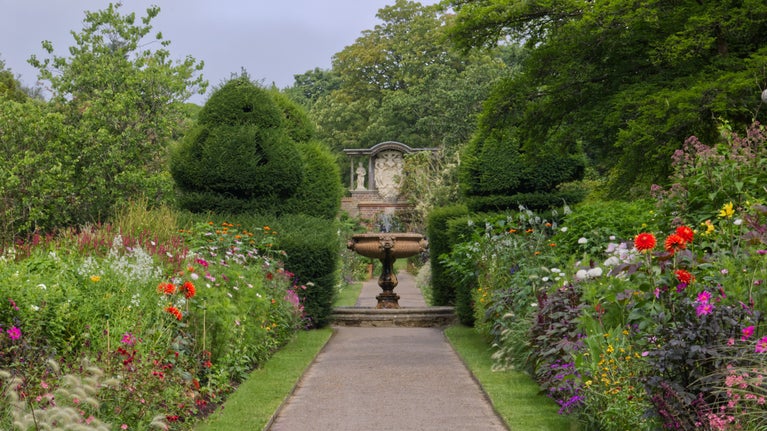
Gardens and landscapes
Find out more about the historical landscapes that the talented garden teams work hard to conserve at the places you love to visit.

Tulips have been a popular flower for centuries. Find out where they came from, how they inspired the 'tulipmania' craze and learn about the different varieties you can still spot today.
Almost half of the 120 known tulip species are native to central Asia, as they thrive in extreme hot summers and harsh, cold winters. Tulips were a powerful emblem for nomadic people and a welcome sign of spring.
Persian poets celebrated the beauty of the tulip in the 11th century and, by the 14th century, wild tulips were being taken and planted in Ottoman palace gardens. It's likely that ambassadors and envoys from Western Europe first saw them in these gardens.
There’s no record of when the first tulip left Asia, but its scarcity and beauty led to a huge desire for tulips in 17th-century Europe, particularly in France and most famously, Holland.
A large part of the fascination with tulips was down to the way they could sometimes transform from a single colour to a flamed flower, in contrasting colours, the following season.
Demand for the most beautiful and rarely seen varieties of tulips in Holland led to a craze known as 'tulipmania'. Coinciding with the Dutch Golden Age (lasting from the late 16th to late 17th century), this craze saw the wealthy wanting to fill their gardens with coveted flamed tulips.
In the early 17th century, artists from the European region known as the Low Countries (The Netherlands, Belgium, and Luxembourg) were among the first to produce paintings that exclusively portrayed flowers. These paintings provide a visual record of the most desirable tulips of the period.
'Tulipmania' reached its peak in Holland in January 1637, when the most sought-after tulips cost thousands of guilders per bulb and the price for a single 'Semper Augustus' – the most prized variety of all – reached 10,000 guilders. This was enough to buy a house and trappings in the most desirable district of Amsterdam.
The gamble of acquiring a bulb, in anticipation of it flowering with the desired break in colour, added to its allure. Unfortunately, the flaming was caused by a virus which wasn't discovered until the 1930s. It weakened and eventually killed the bulbs, making them an even riskier purchase.
Prices escalated to unsustainable levels, leading 'tulipmania' to collapse in a matter of months. The bulbs lost their value and many people were left in financial difficulty.

As gardening tastes changed and moved towards more natural-looking landscapes in the 18th century, tulip cultivation in Britain was adopted by growers known as ‘florists’. Unlike the modern meaning of the word, these florists cultivated a particular flower for its decorative qualities.
These tulips were grown from seed and took up to seven years to produce a flowering bulb. English tulips were classed by their colours: 'Bybloemens' in shades of purple and violet on white; 'Bizarres' in mahogany, scarlet or brown on yellow; and 'Roses' in various shades of red on cream. A tulip known as a ‘breeder’ was one of a uniform colour, yet to break into the sought-after flame and feather patterns.
Like daffodils and dahlias, tulips are divided into different divisions, chiefly defined by the characteristics of their flowers or when they start to bloom. There are 15 in total and they include 'Lily-flowered', 'Rembrandt', 'Viridiflora', 'Parrot' and 'Darwin Hybrid' groups.
Around the middle of the 19th century, tulips were so popular that many towns had a specialist society for growing and showing the flowers. The National Tulip Society was formed in 1849, but by the early 20th century these societies were in decline. Only the Wakefield and North of England Tulip Society, founded in 1835, survives today.
However, the popularity of tulips has endured across the centuries and they remain a favourite spring flower in homes and gardens. Even flame-petaled tulips have been transformed into virus-free, affordable varieties.

Find out more about the historical landscapes that the talented garden teams work hard to conserve at the places you love to visit.
Uncover the horticultural history of the dahlia, from its origins in Central America to becoming an inspiration for legendary crime writer Agatha Christie.

Discover the history behind the daffodil, including how it came to be one of the UK's favourite flowers, where it came from and how to classify its many varieties.

Edwardian hillside garden with year-round features

A unique 17th-century treasure trove

Explore a much-loved home, garden and estate filled with the stories of a family and their servants.

Unique 18th-century mansion, famed for its mixture of architectural styles

Ancient parkland, 17th-century house and garden
